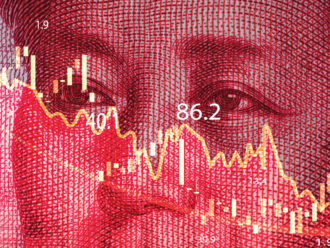Japan stands out among its peers. It is the only major developed economy that has not committed to quantitative tightening and is not yet facing significant inflation.
Both trends have bolstered stock market performance. With the Nikkei and Topix performing relatively better than other developed market indices, Japan has caught the eye of institutional investors. But how long can a developed market economy afford to diverge from its peers?
Amid falling stock markets in Europe and the US, does Japan still offer investors diversification?
Divergence
So far, this year has been rough for equity investors. Faced with the onset of monetary tightening in the US and Europe, the S&P500 has dropped by more than 14%, year-to-date, while the Eurostoxx 50 has fallen by around the same level since the beginning of the year.
But Japan stands out. While Japanese indices such as the Nikkei and Topix have also declined, they have fallen relatively less, by around 5% year-to-date. Why is the Japanese economy following a different path?
A widening gap in currency values is one factor that makes the Japanese economy stand out against other developed markets. While the dollar continues to face structural appreciation pressures, Japan has a long history of competitive devaluations to keep the yen’s value low and bolster export markets.
This trend has been accelerated by the war in Ukraine argues Clay Lowery, executive vice president for research and policy at the Institute of International Finance. “The war in Ukraine has impacted the yen, as it has many global economies by exacerbating supply chain disruptions and harming commodity importing and Japan is a significant commodity importer, particularly of energy. After Russia invaded the Ukraine, the yen depreciated against the US dollar by a further 6%.”
But another, potentially more significant factor is the divergence in monetary policy. Japan, as the birthplace of quantitative easing, continues to face low inflation and has, therefore, not yet committed to monetary tightening.
While the Federal Reserve, the European Central Bank and the Bank of England all have committed to monetary contraction, the Bank of Japan has held back. Compared to other developed markets, it faces relatively low inflation of 2% and has, therefore, less pressure to raise interest rates.
The combination of loose monetary policy and a falling currency go hand-in hand, Lowery says. “The result is that the interest differentials between the United States’ 10-year bond yields and Japanese debt have spiked roughly 350% since 2020.
“To put it simply, holding dollar-backed bonds provides a much higher return than yen-backed bonds, which is a catalyst for selling the yen and buying dollars and voila, the depreciation of the yen,” he adds.
But this system is increasingly coming under pressure, as the yen has fallen to a 24-year low against the dollar. Japan is now at a turning point, facing two fundamentally different outcomes.
If the Bank of Japan continues its policy of easing, then this could push the yen even further downwards. But another scenario is that the nation could meet global inflationary pressures, which would force central bankers to steer away from the course they have followed during the past decade and introduce monetary tightening measures.
All eyes are now on the Bank of Japan, whose policy measures could play a decisive role. Govinda Finn, Japan and developed Asia economist at Kobe University, argues that Haruhiko Kuroda, the outgoing governor of Japan’s central bank, is caught between a rock and a hard place.
“The Bank of Japan is now paying the price for a loss of independence. There are two reasons why it cannot take independent decisions. One is the issue about sustainability of Japanese debt. High debt-to-GDP levels mean that keeping interest rates low has become important. And the second is that the headwinds Japan has seen from a demographic perspective and its low growth environment are not going away,” he says, suggesting that the central bank is likely to keep a relatively accommodative stance for the time being.
Investment impact
The outcome of these decisions matters to UK institutional investors, for many of whom Japanese stocks are a core element of their developed market equity portfolio. For example, Japan accounts for around 8% of the MSCI World index, so many institutional investors will have had exposure to Japan baked in by default.
There are arguments in favour of being overweight Japan. By the end of last year, the Topix started to outperform other developed market indices, a trend which was at least in part driven by investor expectations that the Bank of Japan would continue its loose monetary policy.
One example of a fund that has fared well with its exposure to Japanese stocks is GPIF, the ¥196.6trn (£1.2trn) investment behemoth, which manages the retirement savings of government employees, booked a ¥1.8trn (£14bn) gain on its Japanese equity holdings in the third quarter of 2021 alone.
This upwards trend for Japanese stocks was at least in part driven by the expectation of further accommodative policy in Japan, GPIF president Masataka Miyazono explains. Japanese stocks account for almost a quarter of the pension funds’ asset allocation.
But at the beginning of this year, the picture changed somewhat and Japanese stock markets also started to fall.

The headwinds Japan has seen from a demographic perspective and its low growth environment are not going away.
Govinda Finn, Kobe University
Currency effect
One factor that has always played in GPIF’s favour is the cheaper value of the yen. The rising cost of the dollar has bolstered the investment performance of a fund that pays out benefits in yen. But for UK investors, the precise opposite holds true, as James McLellan, senior portfolio manager at Border to Coast says.
The £60bn local government pension scheme pool has about 10% of its £5bn developed market equity fund invested in Japanese stocks and McLellan is keen to stress this position is not influenced by short-term speculation on the Bank of Japan’s next steps.
“We run a fixed allocation on the equity side which we rebalance on a quarterly basis and so we do not play allocation as a source of alpha or to express our views,” he adds.
But as a fund that measures its performance in sterling, the sharp fall of the yen has affected the investment returns, he says. “The performance of Japanese stocks has been quite good though it t is a different story when you look at it in dollars or even in sterling. It has still done relatively well but it’s not done as well as the headline yen number would suggest,” he adds.
Yet McLellan sees indications that the plunge of the yen may have reached its peak. “Previously when the yen has reached these levels against the Chinese yuan then it has marked a bit of a limit and it becomes more relevant to China because their competitive position is being threatened by the weakness of the yen,” he says.
Nevertheless, he adds that the rise of the dollar remains a wildcard, with little indication that investor demand for the greenback is likely to change.
Finn also believes that the Bank of Japan will approach any changes to the country’s currency with great caution: “The BOJ is very, very sensitive to triggering a yen spike or further volatility in the yen, or a bond sell off,” he says.
Inflation impact
Another key factor that investors in Japan will have to consider is the impact of rising price levels. For decades, Japan has been de ned as a country with persistent deflation. But this could now change. For one, the low value of the yen is driving up import prices, a trend that is aggravated by globally rising energy prices. Japan imports almost 90% of its energy and is therefore extremely vulnerable to global price shocks.
But there are also factors that could explain why Japanese inflation has not yet risen to the extent it has in other developed markets.
For McLellan, developments in the labour market could be a decisive factor. “What might ultimately trigger inflation would be an increase in wages in Japan, we have not seen that for quite some time, despite its tight labour market. If you started to see wage inflation coming through, that could be a sign that inflation is starting to take hold and that might precipitate a more aggressive stance from the Bank of Japan,” he says.
If monetary policy were to tighten as a result of higher inflation, this would, in the first instance, hit Japanese debt markets. Many Japanese investors have borrowed in yen and invested internationally, a carry trade banking on a persisent yen devaluation. This could backfire if the BoJ were to introduce tightening.
But Finn argues that unlike some developed market central banks, the Bank of Japan is quite explicit in saying that it is not responding to inflation by hiking interest rates. It considers the causes of inflation to be rooted in supply side problems, which would be beyond the realm of monetary policy interventions.
In any case, the investment impact of inflation is far from straightforward. While central bank tightening measures could dampen the short-term outlook for equity markets, they would always be weighed against the steps taken by other central banks and as such seen as relatively less severe.
Moreover, analysts highlight that Japanese consumers and corporates sit on relatively high cash levels and inflation could encourage increased spending and investment.
June-Yon Kim, a portfolio manager at Lazard, predicts that tightness in the Japanese labour market could lead to inflation being much more persistent than currently anticipated.
Beyond Macro
With the macro outlook for Japan remaining uncertain, there is also an argument being made that investors should steer away from top down analysis and instead approach investments in the country through a bottom-up lens. And from that perspective, the picture looks a lot less gloomy.
As an advocate of a bottom-up stock picking approach for Japan, Kim argues that global investors have too often focussed on “macro political hooks” to justify their investments, rather than attempting to better understand the nature of Japanese companies.
He highlights that company valuations have become much more attractive. For example, shares have moved from trading at 30 times price-to-earnings ratio to 12 times. Moreover, share buybacks and dividend payments have more than doubled. Kim argues that in being distracted by the macro picture, many investors are overlooking these opportunities.
McLellan also backs this view. “Ultimately, our approach is driven by bottom-up stock selection with an overlay on our top-down macro view which informs our positioning at the margin,” he says. And from that perspective, Japanese stocks still o er opportunities. “Valuations remain attractive, balance sheets continue to be strong and are nicely positioned to weather a downturn. Because Japanese companies have been conservatively run, there is room for margin improvement.
“Companies have the potential to improve margins and release some of that value, that is part of the long-term attraction of Japan rather than necessarily any standout macroeconomic issues,” he adds.





Comments